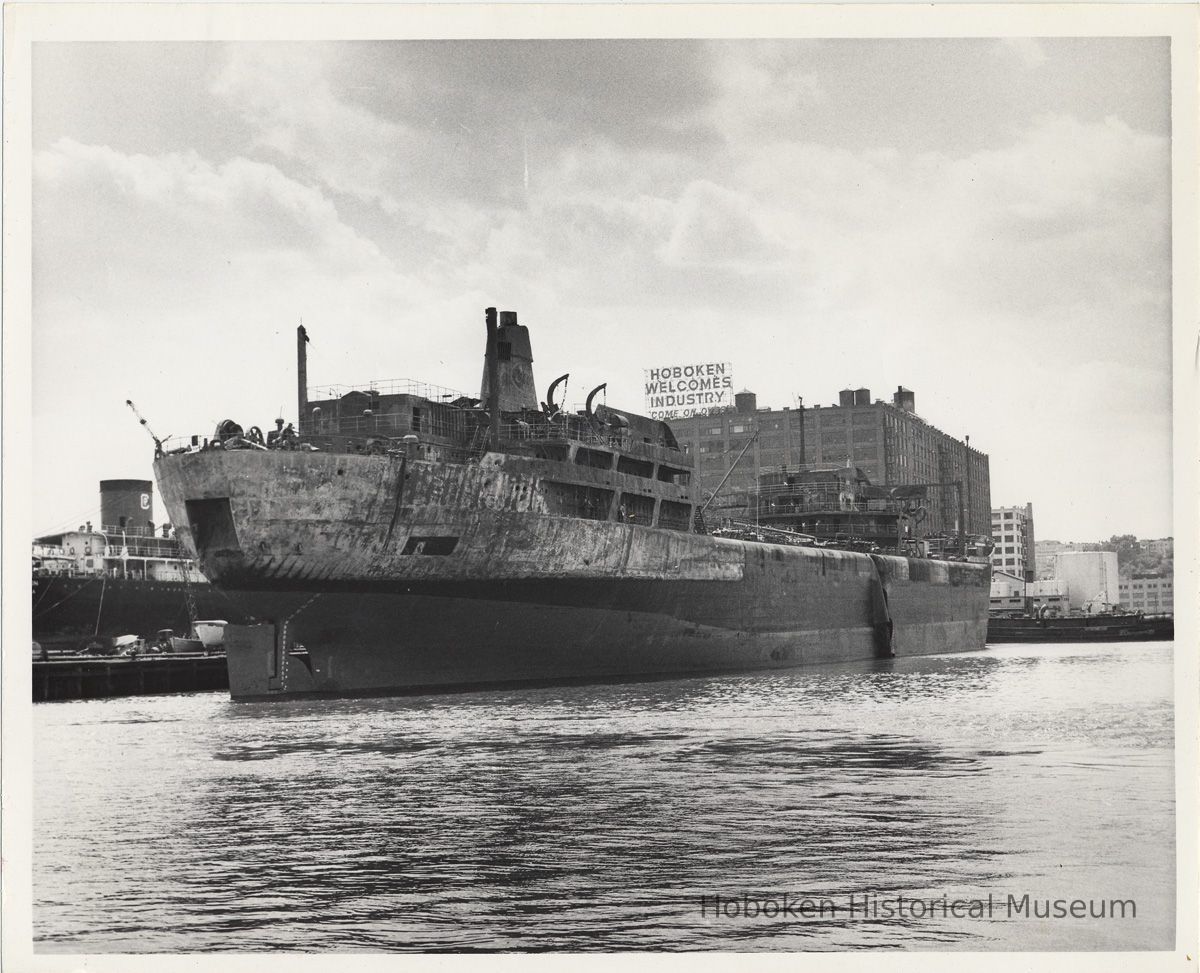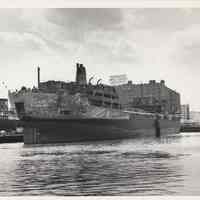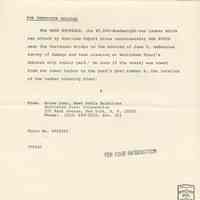Collections Item Detail
B+W photo of tanker Esso Brussels at Bethlehem Steel Shipyard Pier 6, Hoboken, June 1973.
2011.025.0310
2011.025
Cangelosi, Joseph
Gift
Gift of Joseph Cangelosi.
n/a
1973
Hoboken
8 in
10 in
Good
Notes: FOR IMMEDIATE RELEASE The ESSO BRUSSELS, the 40,800-deadweight-ton tanker which was struck by American Export Lines containership SEA WITCH near the Verrazano Bridge on the morning of June 2, undergoes survey of damage and tank cleaning at Bethlehem Steel's Hoboken ship repair yard. On June 15 the vessel was towed from the lower harbor to the yard's pier number 6, the location of the tanker cleaning plant. # From: Bruce Lake, News Media Relations Bethlehem Steel Corporation 375 Park Avenue, New York, N. Y. 10022 Phone: (212) 688-5522, Ext. 311 Photo No. 60224A1 379160 FOR YOUR INFORMATION [end press release] ------------------ Article about the Esso Brussels as posted on Wikipedia May 4, 2011 While useful for a significant amount of information about the vessel and the collision, there appears to be errors of facts regarding the date and number of deaths; it is suggested that readers refer to the official U.S. Coast Guard Marine Casualty Report which states June 2, 1973 and details the casualities.) Career (Belgium) Name: Esso Brussels (1959-73) Petrola XVII (1973-74) Spiro (1974-75) Petrola XXXVI (1976-83) Petrola 36 (1983-85) Owner: Esso Marine (Belgium) SA (1959-73) Iphigenia Shipping & Trading Co (1973-75) John D Latsis (1975-76) Iphigenia Shipping & Trading Co (1976-85) Operator: Esso Marine (Belgium) SA (1959-73) John D Latsis (1973-83) Bilinder Marine Corp (1983-85) Builder: Kockums shipyard FH, Malmö, Sweden Laid down: May 4th, 1959 Launched: 26 October 1959 In service: 1960 Out of service: October 21st, 1985 Homeport: Antwerp (1959-73) Piraeus (1973-85) Fate: Scrapped at Aliaga, Turkey General characteristics Type: Oil Tanker Tonnage: 16,422 NRT 43,964 DWT Length: 213.12 metres (699 ft 3 in) Beam: 29.65 metres (97 ft 3 in) Height: 11.59 metres (38 ft 0 in) Installed power: Two steam turbines (12,309 kilowatts (16,507 hp)), double reduction geared. Propulsion: Single Screw Speed: 17.25 knots (31.95 km/h) Crew: 52 Esso Brussels was a commercial oil tanker built for the Esso Oil company in 1959. She was involved in a collision in 1973 in which thirteen of her crew perished. She was rebuilt and sailed under various other names until being scrapped in 1985. Contents [hide] 1 Construction and service 2 Collision with the container vessel Sea Witch 3 Later life 4 References 5 External links [edit] Construction and service She was built at Kockums shipyard in Malmö, Sweden and launched on 26 October 1959.[1] Following outfitting, she entered commercial service transporting crude and refined oil products for the Esso Oil Company throughout Europe, Africa and North America. Built along classic lines with the bridge and the officer's quarters located amidships and the engines, crew quarters and aft deckhouse located toward the stern, Esso Brussels was a typical oil tanker in both size and design for her time. [edit] Collision with the container vessel Sea WitchThe Esso Brussels dropped anchor in the southernmost anchorage of the Verrazano Narrows in New York Harbor on May 30, 1973, fully loaded with 319,402 barrels of light Nigerian crude oil destined for Exxon's Bayway Refinery. While she waited for the high tide, her mixed European crew of 36 men and one woman, first steward Gisele Rome, under the command of Captain Constant Dert went about their daily routine into the evening of the 30th. When the 12 a.m. to 4 a.m. watch came on duty all seemed normal. At roughly the same time, the containership Sea Witch left the Howland Hook Marine Terminal terminal on Staten Island. She headed for the sea, carrying some 730 containers onboard. Twenty-nine minutes after midnight, the Sea Witch passed the ferry terminal at the tip of St. George, Staten Island and turned to a heading of 167 degrees in order to begin transiting the Narrows separating Staten Island from Brooklyn. Seven minutes later the Sandy Hook pilot Jack Cahill ordered a change in course to 156 degrees so the ship would pass through the shipping lane in the general anchorage. The second turn never occurred. When the ship did not respond as expected, the helmsman told the Captain that Sea Witch was no longer steering. Both the captain's and the pilot's attempts to re-engage the steering gear and check the Sea Witch's continuing turn to starboard proved futile. With all steering control was lost and the ship proceeding at 15 knots with the aide of an outbound tide the Sea Witch was being forced out of the channel toward Staten Island. The Pilot immediately ordered the engines to full astern and the port anchor to be let go in an effort to stop the ship. Blowing a series of short rapid blasts on the ship's whistle signaling that Sea Witch was in distress and ordering the general alarm bell rung to alert the her crew, both the Pilot and the Captain watched as both of her anchors failed to deploy. A mere two and a half minutes after control was lost onboard Sea Witch she was a mere 200 feet from the starboard side of the Esso Brussels and realizing that the ship was not going to be able to stop in time, the Sea Witch's whistle was locked to sound continuously and her crew abandoned the forward section of the ship. The mate standing what was a quiet and uneventful watch on Esso Brussels's bridge heard Sea Witch's distress whistle and watched as the containership began to head out of the channel towards his ship. First thinking that the disabled ship would pass astern of his tanker, the Mate sounded the general alarm as the Sea Witch continued to veer in his direction. With only about two minutes of warning, many of the crew of the Esso Brussels were still below decks when the collision occurred. Making about 13 knots and her engines in full reverse, Sea Witch rammed its ice-reinforced bow into the starboard side of the Esso Brussels between the midship and aft deckhouses, piercing three of the Esso Brussels' cargo tanks and locking the two ships together. The light crude oil spewed out of the punctured tanks and its vapors quickly caught fire wreathing both ships in a pool of burning oil. Despite the sudden chaos on the Esso Brussels Capt. Dert supervised the terrified crew as they abandoned the burning ship onto the only available lifeboat. Having lowered the motorized aft port lifeboat the crew tried to release it from its lines and get its engine started, but the hand crank to start the engine was impossible to operate on the overloaded lifeboat once freed from the ship. Despite the resistance from the anchors of the Esso Brussels, the engines of Sea Witch, still running full reverse, were pulling both ships down the Narrows. This movement created a suction force which pinned the Esso Brussel's lifeboat against the tanker's hull and brought the pool of flaming oil around the to the Port side of the ship. A last-second attempt to row the lifeboat away from the advancing fire failed to overpower the suction, and as the flames grew nearer to the lifeboat, many of the crew jumped into the water in a desperate attempt to escape the flames. Within minutes of the collision the veteran FDNY fireboat Fire Fighter arrived to what the firefighters aboard would later describe as a sea of flames that extended 3,000 yards in front of them. Thinking there had been an explosion on the Esso Brussels, the fireboat began to pour water onto the ship from its starboard bow, keeping their ship upwind and upcurrent from the smoke and flames now heading towards the Verrazano Narrows Bridge. As the two ships passed beneath the bridge, the pool of burning oil surrounding the ships sent flames high enough to scorch the bottom of the bridge 228 feet above the water's surface. Fortunately, the anchor chains on the Esso Brussels parted at this point and both ships passed under the bridge quickly, preventing the steel from suffering heat damage. Propelled by the Sea Witch's still-running engines and the outbound tide, the ships proceeded into outer New York Harbor and ran aground in Gravesend Bay, burning furiously. After both ships grounded, Fire Fighter moved into position and fought the oil fire from the port side of Esso Brussels. To their horror, as they extinguished the fire they saw the bow of Sea Witch was embedded in the starboard side and realized that two vessels were involved in the inferno. Moving quickly along the port side of the containership they began to pour water on the blazing container stack of the Sea Witch and moved toward its stern, hoping to find some evidence of the ships crew, 30 of whom were rescued from the stern of the ship. At dawn on May 31, 1973, the fires from the oil cargo onboard the Esso Brussels were mostly under control, aided by her sound construction which prevented the oil in her undamaged tanks from leaking out or catching fire. Sea Witch was in much worse condition, as almost all the on-deck containers were still burning. The US Coast Guard and FDNY agreed to have tugs separate the vessels to avoid the risk of the rest of the oil aboard the Esso Brussels catching fire. Once separated, the four FDNY fireboats easily extinguished what little oil continued to burn and the hulk of the Esso Brussels was towed to the Military Ocean Terminal at Bayonne to have the balance of her oil cargo removed onto barges for delivery. By this time, tugs and small craft managed to rescue the Esso Brussels survivors from the water, but 13 of her crew were lost and never seen again. Two members of the Sea Witch's crew were lost below decks, unable to escape the fire and heat. [end] Original or Copy: Original Status: OK Status By: dw Status Date: 2011-05-03



